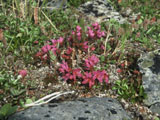Native Plants

Q. Who is Mr. Smarty Plants?
A: There are those who suspect Wildflower Center volunteers are the culpable and capable culprits. Yet, others think staff members play some, albeit small, role. You can torture us with your plant questions, but we will never reveal the Green Guru's secret identity.
Did you know you can access the Native Plant Information Network with your web-enabled smartphone?
Ask Mr. Smarty Plants is a free service provided by the staff and volunteers at the Lady Bird Johnson Wildflower Center.

rate this answer
Friday - August 15, 2008
From: Brooklyn, NY
Region: Northeast
Topic: Non-Natives, Shade Tolerant, Shrubs, Trees
Title: Japanese maple in New York
Answered by: Nan Hampton
QUESTION:
I have a few questions: Do you know what zone Brooklyn, NY. is in? If I plant a Japanese Maple in my backyard, do you think it can tolerate almost full shade (1-2 hours of sun per day)? Also, is it really true that rhododenren require morning sun? I want to plant 2 of them in areas that get 1-2 hours sun in the in the late afternoon. Thanks VERY Much!ANSWER:
USDA Plant Hardiness Zone Map shows that Brooklyn is either in Zone 7a or 6b. The average minimal temperatures are 0 to 5° F for 7a and -5° to 0 F for 6b.
Acer palmatum (Japanese maple) as the name suggests is native to Asia, not North America. Since our area of expertise is plants native to North America we can't really furnish you with firsthand knowledge about the growing requirements of Japanese maple, but we're happy to point you to some information that can help you. Information from Ohio State University and The Garden Helper indicates that the Japanese maple does well in light or partial shade. Some cultivars will tolerate full sun. WorldPlants.com indicates that there are also cultivars that will do well in shade.
We are a bit more knowledgeable about Rhododendrons since there are more than 25 species native to North America and 8 of those are native to New York:
Rhododendron arborescens (smooth azalea)
Rhododendron calendulaceum (flame azalea)
Rhododendron canadense (rhodora)
Rhododendron lapponicum (Lapland rosebay)
Rhododendron maximum (great laurel)
Rhododendron periclymenoides (pink azalea)
Rhododendron prinophyllum (early azalea)
Rhododendron viscosum (swamp azalea)
All of these will grow in partial shade although several hours of sun per day will probably keep them from becoming 'leggy' and will also produce more blooms. Morning sun is preferable to afternoon sun—the disadvantage of the afternoon sun compared to morning sun is the elevated temperature that accompanies the afternoon sun. Since your area receives very little afternoon sun and temperatures are generally not extreme where you live, I would think that your rhododentrons would do fine. Here are some general tips from Flower Gardening Made Easy.
More Trees Questions
Removal of invasive non-native Chinese wisteria
September 10, 2007 - I am going to be removing my ubiquitous chinese wisteria very soon (the method I'm going to use is undetermined). If I decide to use Round-up on the cut-stem (which may take more than one application...
view the full question and answer
Need for smaller tree with less invasive roots from Ft. Worth TX
June 07, 2014 - The sycamore in the front yard has developed roots larger than the branches. They have decided that the water and sewer lines are perfect to acquire their water from. For this reason it will be coming...
view the full question and answer
Are Mesquite (Prosopis) pods safe for dogs to eat?
June 15, 2009 - are pods from mesquite trees posionus to dogs if they chew or eat them?
view the full question and answer
Non-native, and/or invasive bermudagrass, St. Augustine and Pistache from Houston
September 24, 2012 - Our St. Augustine lawn died suddenly this summer from either chinch bugs or grub worms (or both?), and a multitude of weeds and native Bermuda have taken over the area. Now that the weather has cooled...
view the full question and answer
Chilopsis linearis Bubba in Hunt TX
October 18, 2009 - I purchased 3 desert willows (label: chilopsis linearis) to create an oasis area around a fountain which is in the center of my circle drive. But I need one more. Now I can only find the "chilopsis...
view the full question and answer
| Support the Wildflower Center by Donating Online or Becoming a Member today. |

